An Optimal Authentication Scheme through Dual Signature for the Internet of Medical Things
Abstract
1. Introduction
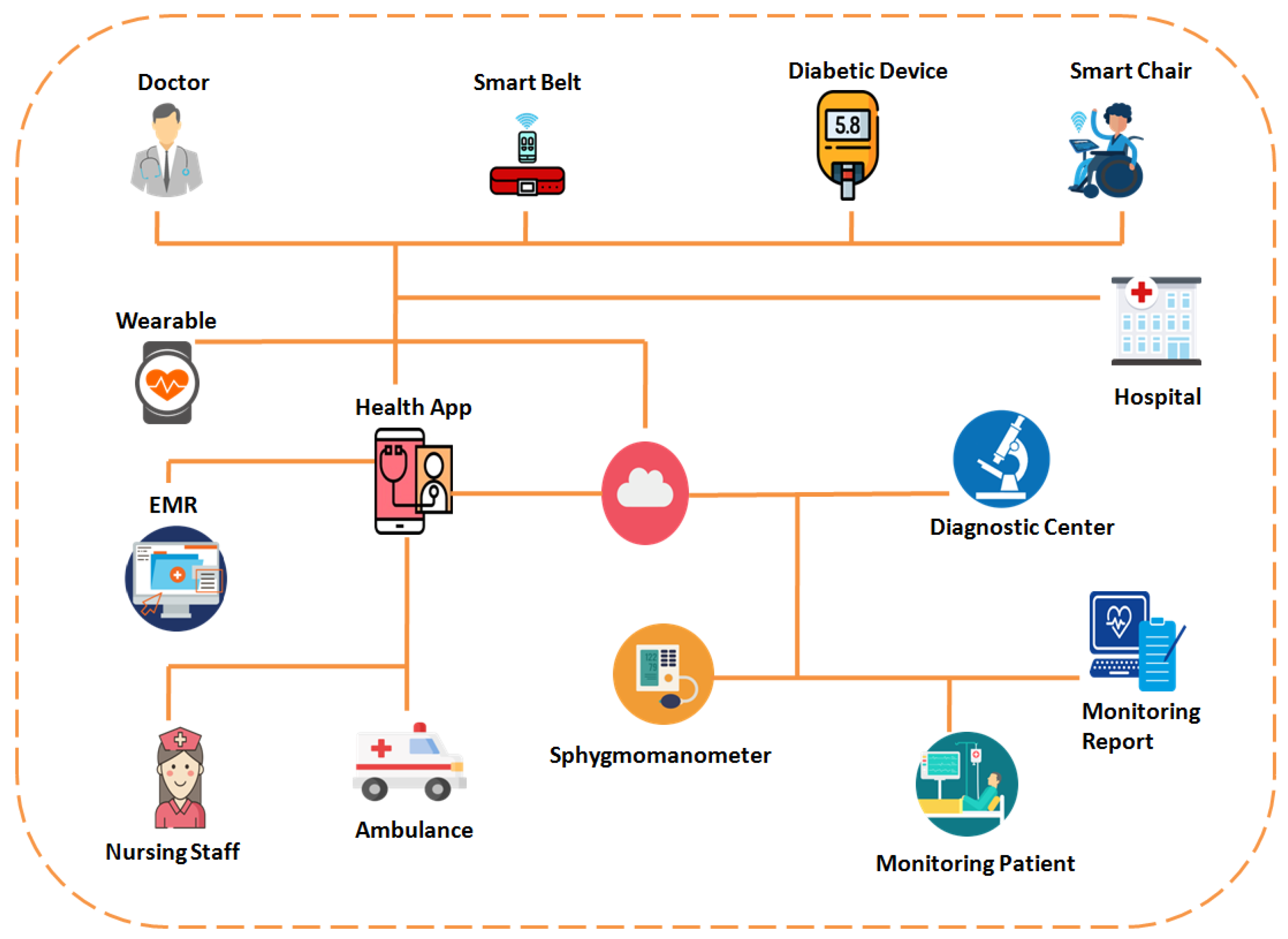
Motivation and Contributions
- We propose a dual-signature scheme using hyperelliptic curve cryptography (HECC), an advanced form of elliptic curve cryptography (ECC) that provides the same level of security as ECC with a key size that is half that of ECC.
- We provide an informal security analysis study in terms of authentication, integrity, and non-repudiation, and demonstrate that the proposed scheme is resistant to these attacks.
- In addition, we evaluated the security criteria using the security validation tool Scyther, and the results indicate that the proposed scheme is secure against man-in-the-middle attacks.
- Finally, we compared the performance of the proposed scheme to that of related schemes from the literature and observed that the proposed scheme lowered computation and communication costs.
2. Preliminaries
2.1. Hyperelliptic Curve
2.2. Divisor
2.3. HECDLP
2.4. Syntax
3. Related Work
4. Network Model
5. Proposed Dual Signature Scheme
5.1. Setup
5.2. Key Generation
5.3. Key Generation for IoMT Devices
5.4. Key Generation for PDA
5.5. Key Generation for AP
5.6. Dual Signature
- Compute and , where α belongs to , which is private to IoMT devices
- Compute , , and
- Compute and send () to PDA.
5.7. PDA Verification
- Compute if it is qualified then it accepts the signature
- Then send () to AP
5.8. AP Decryption and Verification
- It decrypts , where is the private key of AP.
- It accepts the , when is satisfied.
5.9. Correctness
6. Informal Security Analysis
6.1. Data Privacy
6.2. Replay Attack
6.3. Authentication
6.4. Data Tampering
6.5. Integrity
6.6. Nonrepudiation
7. Computational Cost
- Raspberry PI 4B (2019)
- CPU Architecture: 64 b
- Processor: 1.5 GHz Quad-core
- OS: Ubuntu 20.04.2 LTS with 8 GB memory
8. Communication Overhead
9. Conclusions
Author Contributions
Funding
Data Availability Statement
Conflicts of Interest
Appendix A. Scyther Overview

Appendix B. Formal Validation of Proposed Protocol Using Scyther
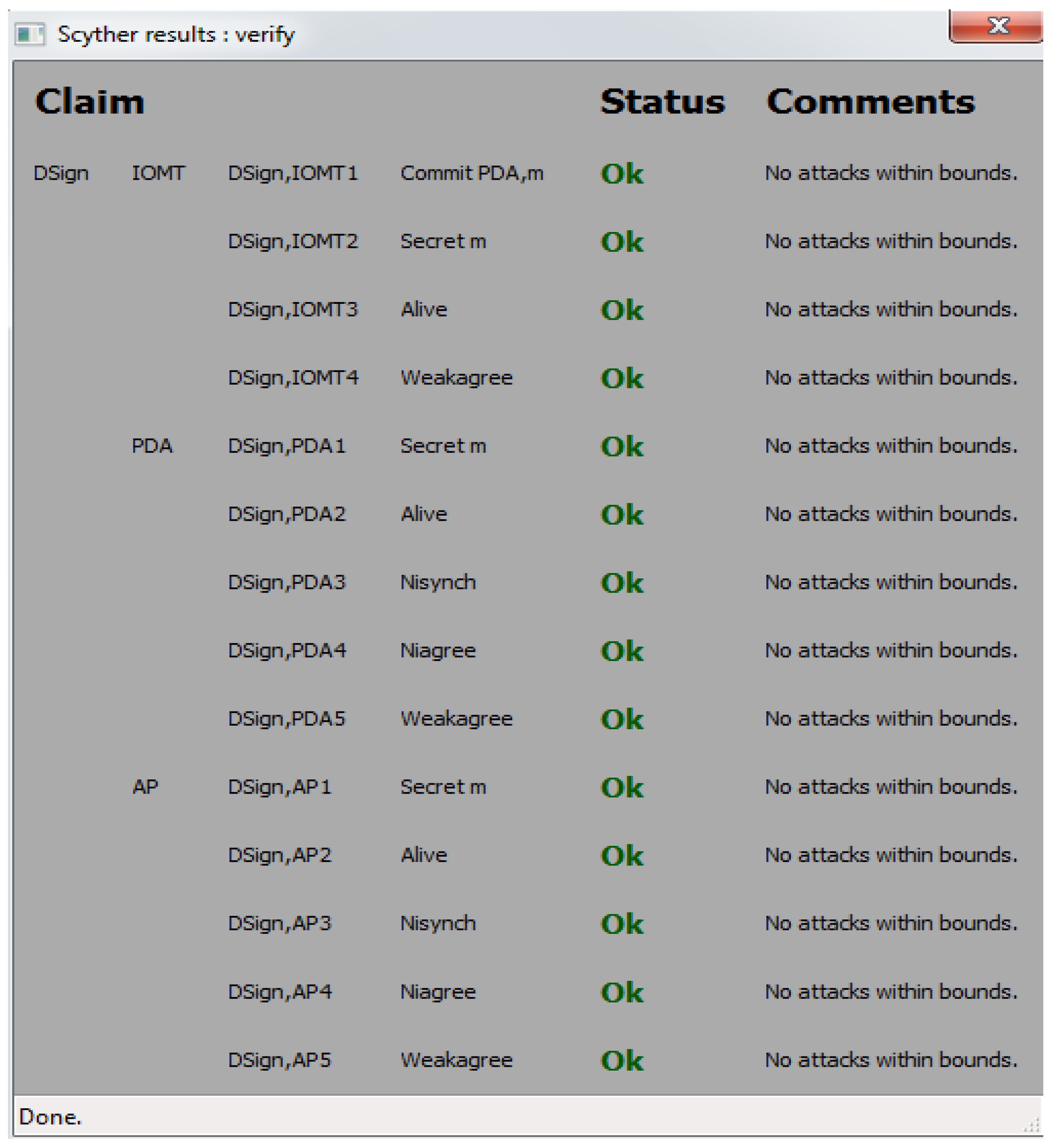
| No | Acronym | Stands for |
|---|---|---|
| 1 | IoMT | Internet of medical things |
| 2 | IoT | Internet of things |
| 3 | ECG | electrocardiogram |
| 4 | SET | secure electronic transaction |
| 5 | RSA | Rivest-Shamir-Adleman |
| 6 | ECC | elliptic-curve cryptography |
| 7 | HECC | hyper-elliptic curve cryptography |
| 8 | HECDLP | hyper-elliptic curve discrete logarithm problem |
| 9 | IKE | Internet Key Exchange |
| 10 | ECDSA | elliptic curve digital signature |
| 11 | CA | central authority |
| 12 | AP | application providers |
| 13 | PDA | personal digital assistant |
| 14 | PHI | personal health information |
| 15 | EMM | elliptic curve modular multiplication |
| 16 | HEMM | hyper elliptic curve modular multiplication |
References
- Forestiero, A.; Papuzzo, G. Agents-Based Algorithm for a Distributed Information System in Internet of Things. IEEE Internet Things J. 2021, 8, 16548–16558. [Google Scholar] [CrossRef]
- Forestiero, A.; Papuzzo, G. Recommendation platform in Internet of Things leveraging on a self-organizing multiagent approach. Neural Comput. Appl. 2022, 34, 16049–16060. [Google Scholar] [CrossRef]
- Joyia, G.J.; Liaqat, R.M.; Farooq, A.; Rehman, S. Internet of Medical Things (IOMT): Applications, Benefits and Future Challenges in Healthcare Domain. J. Commun. 2017, 12, 240–247. [Google Scholar] [CrossRef]
- Razdan, S.; Sharma, S. Internet of Medical Things (IoMT): Overview, Emerging Technologies, and Case Studies. IETE Tech. Rev. 2021, 39, 775–788. [Google Scholar] [CrossRef]
- Akhtar, M.; Shatat, R.S.A.; Shatat, A.S.A.; Alam Hameed, S.; Alnajdawi, S.I. IoMT-based smart healthcare monitoring system using adaptive wavelet entropy deep feature fusion and improved RNN. Multimed. Tools Appl. 2022, 82, 17353–17390. [Google Scholar] [CrossRef]
- Ghorbel, A.; Bouguerra, S.; Ben Amor, N.; Jallouli, M. Cloud based mobile application for remote control of intelligent wheelchair. In Proceedings of the 14th International Wireless Communications & Mobile Computing Conference (IWCMC), Limassol, Cyprus, 25–29 June 2018; pp. 1249–1254. [Google Scholar] [CrossRef]
- Udgata, S.K.; Suryadevara, N.K. COVID-19, Sensors, and Internet of Medical Things (IoMT). In Internet of Things and Sensors Network for COVID-19; Springer: Singapore, 2021; pp. 39–53. [Google Scholar] [CrossRef]
- Ray, P.P.; Chowhan, B.; Kumar, N.; Almogren, A. BIoTHR: Electronic Health Record Servicing Scheme in IoT-Blockchain Ecosystem. IEEE Internet Things J. 2021, 8, 10857–10872. [Google Scholar] [CrossRef]
- Dilawar, N.; Rizwan, M.; Ahmad, F.; Akram, S. Blockchain: Securing Internet of Medical Things (IoMT). Int. J. Adv. Comput. Sci. Appl. 2019, 10. [Google Scholar] [CrossRef]
- Gatouillat, A.; Badr, Y.; Massot, B.; Sejdic, E. Internet of Medical Things: A Review of Recent Contributions Dealing with Cyber-Physical Systems in Medicine. IEEE Internet Things J. 2018, 5, 3810–3822. [Google Scholar] [CrossRef]
- Chen, C.-M.; Liu, S.; Chaudhry, S.A.; Chen, Y.-C.; Khan, M.A. A Lightweight and Robust User Authentication Protocol with User Anonymity for IoT-Based Healthcare. Comput. Model. Eng. Sci. 2022, 131, 307–329. [Google Scholar] [CrossRef]
- Sarkar, A.; Tripathi, S. Design of a Dual Signature Scheme using ECDSA in Set Protocol. Int. J. Comput. Appl. 2014, 88, 1–5. [Google Scholar] [CrossRef]
- Chaudhry, S.A.; Irshad, A.; Khan, M.A.; Khan, S.A.; Nosheen, S.; AlZubi, A.A.; Bin Zikria, Y. A Lightweight Authentication Scheme for 6G-IoT Enabled Maritime Transport System. IEEE Trans. Intell. Transp. Syst. 2021, 24, 2401–2410. [Google Scholar] [CrossRef]
- Ullah, I.; Amin, N.U.; Almogren, A.; Khan, M.A.; Uddin, M.I.; Hua, Q. A Lightweight and Secured Certificate-Based Proxy Signcryption (CB-PS) Scheme for E-Prescription Systems. IEEE Access 2020, 8, 199197–199212. [Google Scholar] [CrossRef]
- Ullah, I.; Amin, N.U.; Khan, J.; Rehan, M.; Naeem, M.; Khattak, H.; Khattak, S.J.; Ali, H. A Novel Provable Secured Signcryption Scheme : A Hyper-Elliptic Curve-Based Approach. Mathematics 2019, 7, 686. [Google Scholar] [CrossRef]
- Ullah, Z.; Zeb, A.; Ullah, I.; Awan, K.M.; Saeed, Y.; Uddin, M.I.; Al-Khasawneh, M.A.; Mahmoud, M.; Zareei, M. Certificateless Proxy Reencryption Scheme (CPRES) Based on Hyperelliptic Curve for Access Control in Content-Centric Network (CCN). Mob. Inf. Syst. 2020, 2020, 4138516. [Google Scholar] [CrossRef]
- Wuu, L.C.; Chen, K.Y.; Lin, C.M. Off-Line Micro Payment Scheme with Dual Signature. J. Comput. 2008, 19. [Google Scholar]
- Yalamanchili, S.; Rao, K. Two-Stage Authentication for Wireless Networks Using Dual Signature and Symmetric Key Protocol. Int. J. Comput. Sci. Commun. 2011, 2, 419–422. [Google Scholar]
- Cai, Z.; Zhang, Q.; Li, M.; Gan, Y.; Zhang, J. Multi-Domain Authentication Protocol Based on Dual-Signature. TELKOMNIKA Telecommun. Comput. Electron. Control 2014, 13, 290–298. [Google Scholar] [CrossRef][Green Version]
- Saqib, M.N.; Kiani, J.; Shahzad, B.; Anjum, A.; Malik, S.U.R.; Ahmad, N.; Khan, A.U.R. Anonymous and formally verified dual signature based online e-voting protocol. Clust. Comput. 2018, 22, 1703–1716. [Google Scholar] [CrossRef]
- Cano, M.-D.; Cañavate-Sanchez, A. Preserving Data Privacy in the Internet of Medical Things Using Dual Signature ECDSA. Secur. Commun. Networks 2020, 2020, 4960964. [Google Scholar] [CrossRef]
- Zhang, M.-H.; Xie, J.-H. High fidelity quantum blind dual-signature protocols. Mod. Phys. Lett. B 2022, 36, 2250064. [Google Scholar] [CrossRef]
- Zhang, K.; Zhao, X.; Zhang, L.; Tian, G.; Song, T. A Quantum Dual-Signature Protocol Based on SNOP States without Trusted Participant. Entropy 2021, 23, 1294. [Google Scholar] [CrossRef] [PubMed]
- Shi, J.; Chen, S.; Liu, J.; Li, F.; Feng, Y.; Shi, R. Quantum Dual Signature with Coherent States Based on Chained Phase-Controlled Operations. Appl. Sci. 2020, 10, 1353. [Google Scholar] [CrossRef]
- Sun, Y.; Lo, F.P.-W.; Lo, B. Security and Privacy for the Internet of Medical Things Enabled Healthcare Systems: A Survey. IEEE Access 2019, 7, 183339–183355. [Google Scholar] [CrossRef]
- Koutras, D.; Stergiopoulos, G.; Dasaklis, T.; Kotzanikolaou, P.; Glynos, D.; Douligeris, C. Security in IoMT Communications: A Survey. Sensors 2020, 20, 4828. [Google Scholar] [CrossRef]
- Yu, S.; Das, A.K.; Park, Y.; Lorenz, P. SLAP-IoD: Secure and Lightweight Authentication Protocol Using Physical Unclonable Functions for Internet of Drones in Smart City Environments. IEEE Trans. Veh. Technol. 2022, 71, 10374–10388. [Google Scholar] [CrossRef]
- Ullah, I.; Amin, N.U.; Khan, M.A.; Khattak, H.; Kumari, S. An Efficient and Provable Secure Certificate-Based Combined Signature, Encryption and Signcryption Scheme for Internet of Things (IoT) in Mobile Health (M-Health) System. J. Med. Syst. 2020, 45, 4. [Google Scholar] [CrossRef]
- Ullah, I.; Khan, M.A.; Khan, F.; Jan, M.A.; Srinivasan, R.; Mastorakis, S.; Hussain, S.; Khattak, H. An Efficient and Secure Multi-message and Multi-receiver Signcryption Scheme for Edge Enabled Internet of Vehicles. IEEE Internet Things J. 2021, 9, 2688–2697. [Google Scholar] [CrossRef]
- Cremers, C.J.F. Scyther: Semantics and Verification of Security Protocols; Technische Universiteit Eindhoven: Eindhoven, The Netherlands, 2006. [Google Scholar] [CrossRef]
- Cremers, C.J.F. Scyther: Unbounded Verification of Security Protocols; Technical Report 572; ETH Zurich, Department of Computer Science: Zurich, Switzerland, 2011. [Google Scholar] [CrossRef]
- Alharbi, E.; Alsulami, N.; Batarfi, O. An Enhanced Dragonfly Key Exchange Protocol against Offline Dictionary Attack. J. Inf. Secur. 2015, 06, 69–81. [Google Scholar] [CrossRef][Green Version]
- Kang, N.; Kim, J. Entity Authentication and Secure Registration for Lightweight Devices in Internet of Things. Int. J. Control Autom. 2018, 11, 37–48. [Google Scholar] [CrossRef]
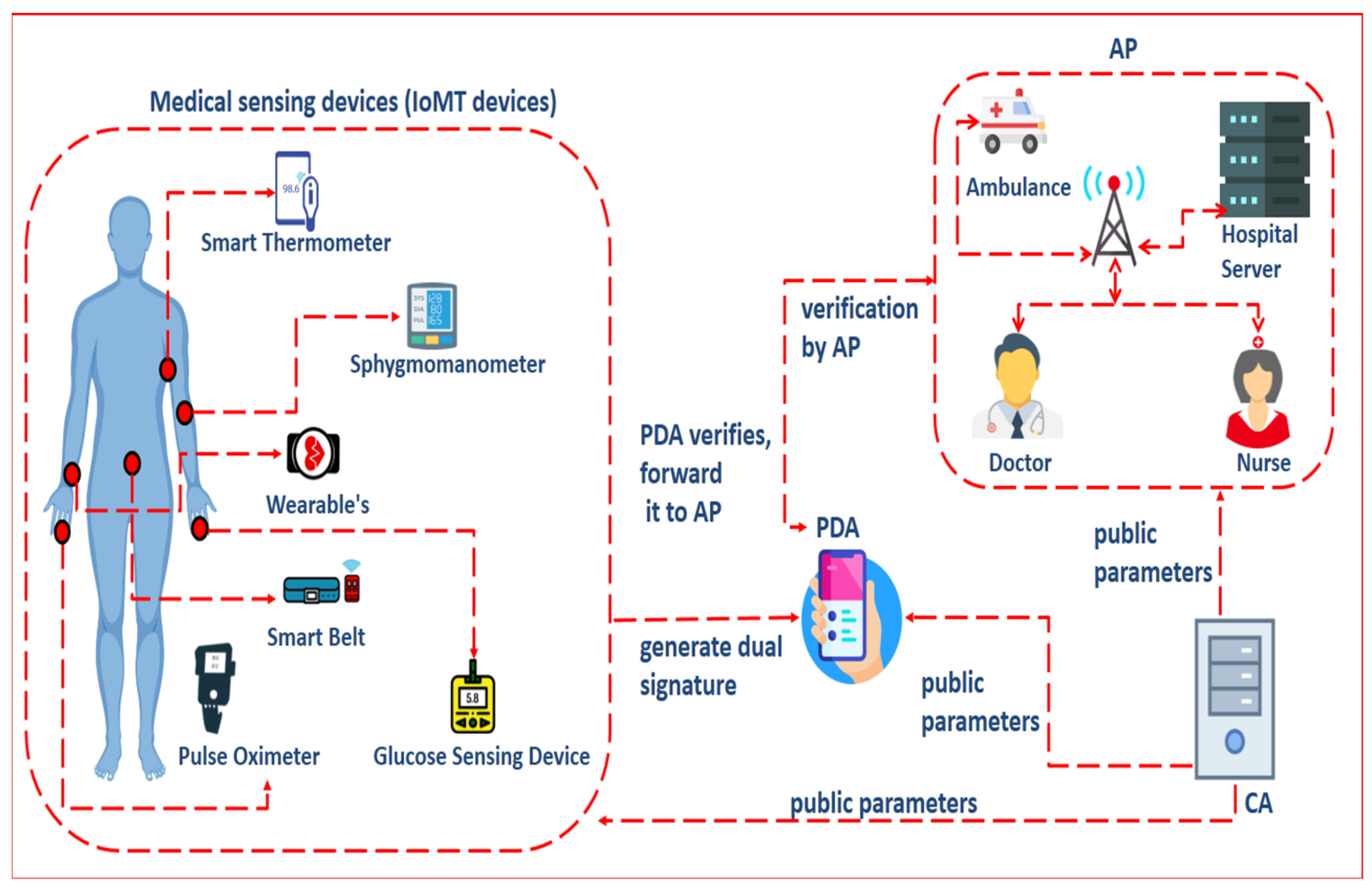
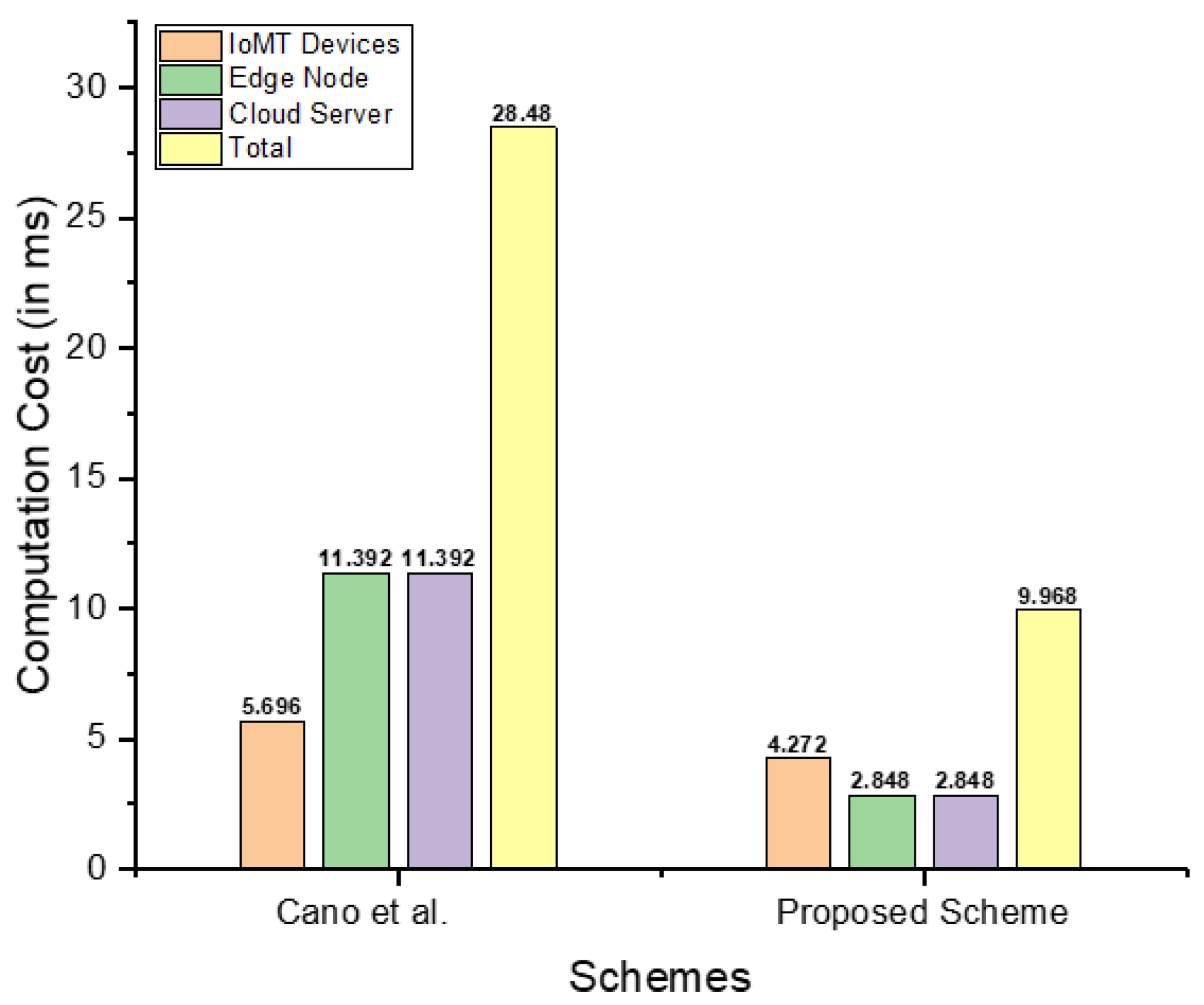
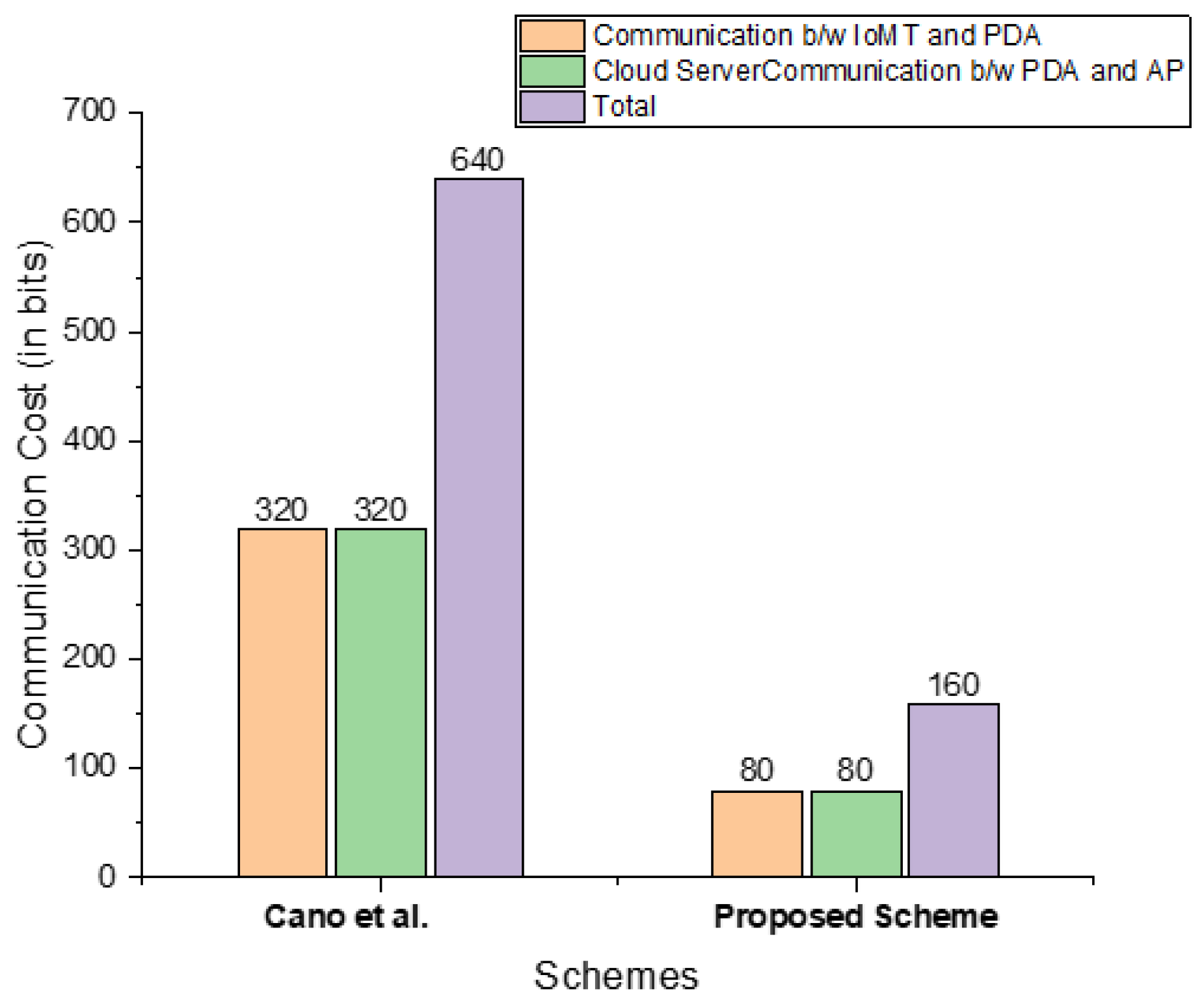
| S. No | Symbols | Description |
|---|---|---|
| 1 | Public key of IoMT device | |
| 2 | Private key of IoMT device | |
| 3 | Divisor on hyper elliptic curve | |
| 4 | A finite field of hyper elliptic curve | |
| 5 | Public key of PDA | |
| 6 | Private key of PDA | |
| 7 | Public key of AP | |
| 8 | Private key of AP | |
| 9 | Plaintext that contains patient health information | |
| 10 | Cipher text that contains patient health information in encrypted form | |
| 11 | Used as a hash function | |
| 12 | Represents a large number and its value as | |
| 13 | Represents a dual signature |
| Schemes | IoMT Devices | PDA | AP | Total |
|---|---|---|---|---|
| Cano et al. [21] | ||||
| Proposed scheme |
| Schemes | IoMT Devices | Edge Node | Cloud Server | Total |
|---|---|---|---|---|
| Cano et al. [21] | 2(2.848) = 5.696 | 4(2.848) = 11.392 | 4(2.848) = 11.392 | 10(2.848) = 28.48 |
| Proposed scheme | 3(1.424) = 4.272 | 2(1.424) = 2.848 | 2(1.424) = 2.848 | 7(1.424) = 9.968 |
| Reduction | ||||
| Scheme | Communication b/w IoMT and PDA | Communication b/w PDA and AP | Total |
|---|---|---|---|
| Cano et al. [21] | = 2 * 160 = 320 | = 2 * 160 = 320 | 640 |
| Proposed scheme | = 80 | = 80 | 160 |
| Reductions | |||
Disclaimer/Publisher’s Note: The statements, opinions and data contained in all publications are solely those of the individual author(s) and contributor(s) and not of MDPI and/or the editor(s). MDPI and/or the editor(s) disclaim responsibility for any injury to people or property resulting from any ideas, methods, instructions or products referred to in the content. |
© 2023 by the authors. Licensee MDPI, Basel, Switzerland. This article is an open access article distributed under the terms and conditions of the Creative Commons Attribution (CC BY) license (https://creativecommons.org/licenses/by/4.0/).
Share and Cite
Jamroz, Z.; Ullah, I.; Hassan, B.; Amin, N.U.; Khan, M.A.; Lorenz, P.; Innab, N. An Optimal Authentication Scheme through Dual Signature for the Internet of Medical Things. Future Internet 2023, 15, 258. https://doi.org/10.3390/fi15080258
Jamroz Z, Ullah I, Hassan B, Amin NU, Khan MA, Lorenz P, Innab N. An Optimal Authentication Scheme through Dual Signature for the Internet of Medical Things. Future Internet. 2023; 15(8):258. https://doi.org/10.3390/fi15080258
Chicago/Turabian StyleJamroz, Zainab, Insaf Ullah, Bilal Hassan, Noor Ul Amin, Muhammad Asghar Khan, Pascal Lorenz, and Nisreen Innab. 2023. "An Optimal Authentication Scheme through Dual Signature for the Internet of Medical Things" Future Internet 15, no. 8: 258. https://doi.org/10.3390/fi15080258
APA StyleJamroz, Z., Ullah, I., Hassan, B., Amin, N. U., Khan, M. A., Lorenz, P., & Innab, N. (2023). An Optimal Authentication Scheme through Dual Signature for the Internet of Medical Things. Future Internet, 15(8), 258. https://doi.org/10.3390/fi15080258








